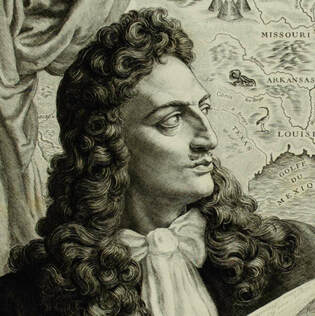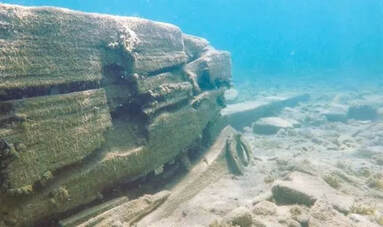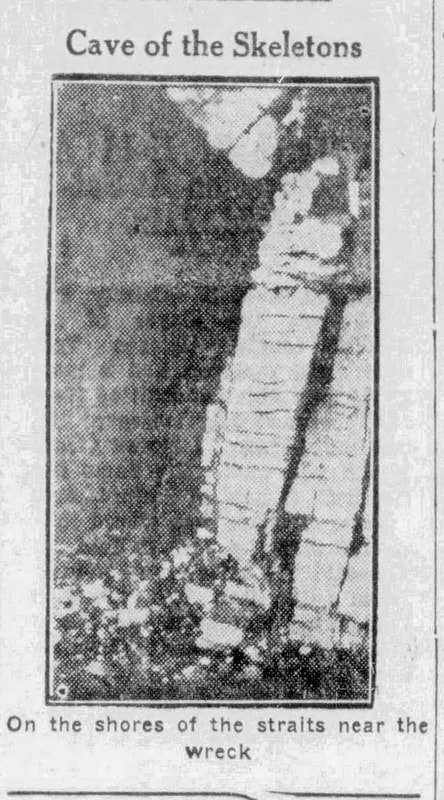 By M.P. Pellicer | Stranger Than Fiction Stories One of the greatest mysteries of the Great Lakes' region is the fate of the ghost ship Le Griffon, which disappeared in 1679 while on its maiden voyage.  Rene-Robert La Salle Rene-Robert La Salle The vessel was built by Rene-Robert Cavalier, Sieur de la Salle (1643-1687), a French explorer who hoped to find a route through the Great Lakes in order to reach Asia. Built on the Niagara River, she was a ship of 60 tons burden, and fitted with two masts. Loaded with furs, the vessel was believed to have sunk in Lake Michigan amid rumors that it was cursed by Metiomek, an Iroquois tribesman, who said the ship would sink in deep water. The boat was launched on August 7, 1679, with a crew of 32, which included LaSalle and Father Louis Hennepin. It traversed Lake Huron and Lake Michigan that had only been explored before on canoes. On September 18, La Salle disembarked and sent the ship back to Niagara with a crew of six. After a stop at Washington or Rock Island, neither the vessel or the crew were seen again. The ship was navigated by pilot Luc or Lucas, a giant Danish or Dutch man and five able seamen. After the ship disappeared LaSalle sent Chapelle and LaBlanc to circumnavigate Lake Huron, but nothing was found. The following spring LaSalle found bits of her wreckage at Michillimachinac Island, which included a bundle of furs, a hatch, a cabin door and a flagpole. There are different versions as to what happened to Le Griffon. Father Louis Hennepin said it was claimed by a violent storm, others believed natives set it on fire after they boarded and killed the crew. Lastly the Jesuits are believed to be responsible for the disappearance. H.G. Tucker, an attorney who died in 1929, had seen weathered timbers as a youth, which he later came to believe belonged to the Griffin. He was a student of historian Francis Parkman who authored The Jesuits in North America in the Seventeenth Century. In 1928, H. G. Tucker lectured on La Salle, and that the ship Le Griffon was wrecked on Manitoulin Island in Lake Huron. This was based on claims of lighthouse keeper Albert Cullis dating back to 1898, saying he found remnants of the ship on the western edge of the island. Results of testing some of the artifacts were disputed. Many of the recovered artifacts were lost, and the wreck was washed away in 1942. Tucker claimed to have visited the wreck, which followed the drawing made by Father Hennepin. He described what he found thus: The heavy oak cross beam which held the rear poop housing is fifteen inches square, fairly sound in the center. She was built almost solid of wood held together by innumerable heavy iron bolts. One of the fore and aft oak timbers is cracked and out of this crack has grown a black cherry tree, much battered but still living. I obtained two rammers for muzzle loading cannon and other articles showing the vessel to have been armed. A round solid shot was found near the wreck is now found near the wreck and is now owned by Crown Attorney McRae of Gore Bay. About ten years ago John Francis, an Indian ninety years of age, told the postmaster at Meldrum Bay that his father, who had died many years before had seen the wreck when a boy, and he also died over ninety years of age.  What was believed to the remnants of Le Griffon c.1931 (Source - The Sault Daily Star) What was believed to the remnants of Le Griffon c.1931 (Source - The Sault Daily Star) He said that six skulls of white men were found many years before in a cave by the wreck. One of these was that of a giant which corresponded with Lucs, the pilot in charge, and the other belonged to the five seamen that accompanied him. Tucker believed the wreck had wedges of native copper between the seams of the plankings, and that bell-shaped pieces of lead found near the wreck were rammers for a brass cannon. A round shot found miles away were in the possession of Crown Attorney McRae of Goro Bay, and that it probably came from the Griffin's guns. Tucker believed the loss of the ship spurred LaSalle to name the post he built afterward as Crevecoeur, which translates to Fort Heartbreak. Small, burned burned pieces of a wreck near the Mississagi Lighthouse, and called by the Indians "the White man's ship" was believed by several historians, besides H.G. Tucker to be what was left of Le Griffon. According to island reporter Grant Turner, a local lighthouse keeper named W.A. Grant witnessed natives taking lead from the seams of the ship, to be used as fish weights and bullets. Other sources described a relic which was a 3.5 inch swab found next to the wreck, supposedly used to load a cannon. In 1931, Charles Henry Snider with the Toronto Evening Telegram wrote about the find. Historians George Fox and Roy Fleming visited the area of Cayuga Creek to sample oak trees for their research on the Manitoulin shipwreck. He described where they recovered a bolt and sent it to metallurgist Sir Robert A. Hadfield in London, who found a high phosphorous content that indicated it was manufactured before the 18th century. The wood sample was found to be white oak, which didn't match the trees grown near the Niagara River. There were different local legends pertaining to the discovery of skeletons inside a cave on Manitoulin Island. In one, it was Mennonite hunters who found a complete skeleton that was nearly 7 feet tall, with a pumpkin-size skull. Another was made by lighthouse keepers Cullis and Holdsworth in 1934, in which "tokens" were found near the remains; one square, one triangular, and two circular. They were believed to be buttons with French insignia. There was also reports of a brass or silver watch recovered by the skeletons. There is a Cave of the Skeletons, which present day is privately owned, but in 1938, looked like a depression near a large boulder and it was not the Mindemoya Cave. The skulls supposed to belong to the crew were kept at the lighthouse, a mile and a quarter from the wreck for some time, and were supposedly thrown into the lake by a keeper when a violent tempest threatened to sweep away the lighthouse. This happened around 1890. In 1899, during the time William Cullis was the lighthouse keeper, he along with his helper John Holdsworth were trying to unearth a rabbit. which dove into a hole close to the wreck. From inside they found a battered silver watch case which was badly oxidized. The works were ruined and there were no identifying marks. Cullis kept the watch, but he died in 1924, and no one knows what he did with the watch. The hole into which the rabbit disappeared, was found to be a fissure connecting with the cave where the skulls were found.  Griffin shipwreck (Source - Steve and Kathie Liebert) Griffin shipwreck (Source - Steve and Kathie Liebert) The Further Adventures of Rene-Robert Cavalier, Sieur de la Salle The LaSalle family was well off and lived in Rouen, France. Rene-Robert's older brother Jean became a Sulpician priest, and in 1660 Robert took initial orders with the Jesuits. Forced to reject his father's legacy in order to join the order, he traveled to North America as a very poor man. Seven years after he joined, he asked to be released from the Jesuits citing "moral weaknesses." He was granted a seigneurie on the Island of Montreal. He set up a village, and learned the language of several tribes who lived in the area. LaSalle undertook several expeditions, from 1669 until 1684. In that year he departed France back to America with an expedition, hoping to establish a French Colony at the mouth of the Mississippi on the Gulf of Mexico. The expedition which included 300 colonists, were harassed by pirates and Indians. One ship was taken by pirates in the West Indies, and another sank in Matagorda Bay. It was the La Belle which finally landed in what is present-day Victoria, Texas. The ship ran aground and sank, stranding those at the settlement; meanwhile LaSalle had marched eastward trying to find the mouth of the Mississippi. Near to what is present day Navasota, Texas, some of LaSalle's men mutinied and he was ambushed and killed by Pierre Duhaut on March 19, 1687. James Hiems shot Duhaut, and in the following weeks others in the group were killed. By 1688, the colony had been decimated and the remaining 20 were slaughtered by Karankawa-speaking Indians, who took five children as captives. Eventually it was learned there were 15 survivors of the original 180 people, minus the ones which left with LaSalle to find the mouth of the Mississippi, and were not at the fort during the massacre. The five children who were kidnapped and the ten adults who were later captured, all went on to live with the Indians. They would later be rescued by the Spanish. In 1995, the ship La Belle was found in the mud of Matagorda Bay. As to the whereabouts of the Griffin, Kathie and Steve Liebert found a bowsprit which they believed was the wreck of the ship in 2001, near small, uninhabited Poverty Island in Lake Michigan. The details were not known until they released their book in 2021, titled, Le Griffon and the Huron Islands — 1679: Our Story of Explorations and Discovery. From 2002 to 2013, they battled the state of Michigan over ownership of the artifacts. Steve Liebert said there was no fire damage to the remains, and he believes the ship sank due to severe weather. The Griffin would go on to become a ghost ship being sighted on moonlit nights, with her crew on board chanting a dirge.
0 Comments
Your comment will be posted after it is approved.
Leave a Reply. |
Stranger Than Fiction StoriesM.P. PellicerAuthor, Narrator and Producer Archives
July 2024
Categories
All
|
Stories of the Supernatural
- Stories of the Supernatural
- Miami Ghost Chronicles
- M.P. Pellicer | Author
- Stranger Than Fiction Stories
- Eerie News
- Supernatural Storytime
-
Astrology Today
- Tarot
- Horoscope
- Zodiac
-
Haunted Places
- Animal Hauntings
- Belleview Biltmore Hotel
- Bobby Mackey's Honky Tonk
- Brookdale Lodge
- Chacachacare Island
- Coral Castle
- Drayton Hall Plantation
- Jonathan Dickinson State Park
- Kreischer Mansion
- Miami Biltmore Hotel
- Miami Forgotten Properties
- Myrtles Plantation
- Pinewood Cemetery
- Rolling Hills Asylum
- St. Ann's Retreat
- Stranahan Cromartie House
- The Devil Tree
- Trans-Allegheny Lunatic Asylum
- West Virginia Penitentiary
- Paranormal Podcasts
"When misguided public opinion honors what is despicable and despises what is honorable, punishes virtue and rewards vice, encourages what is harmful and discourages what is useful, applauds falsehood and smothers truth under indifference or insult, a nation turns its back on progress and can be restored only by the terrible lessons of catastrophe."
- Frederic Bastiat
- Frederic Bastiat

Copyright © 2009-2024 Eleventh Hour LLC. All Rights Reserved ®
DISCLAIMER
DISCLAIMER




 RSS Feed
RSS Feed
















